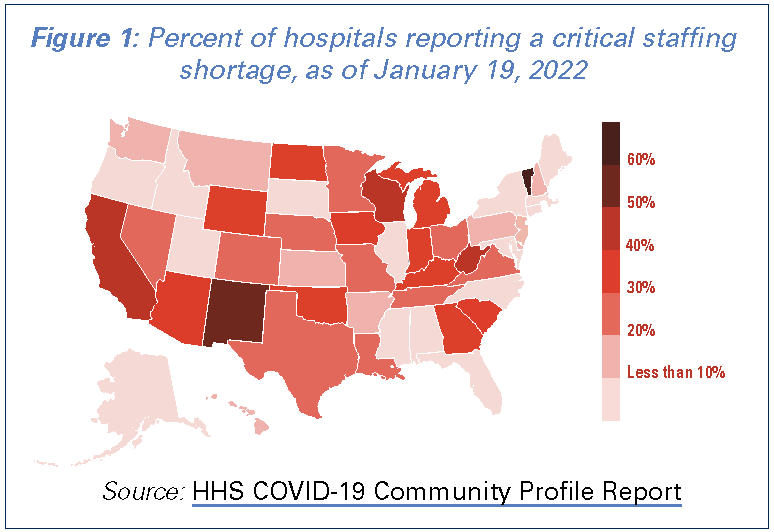WORKFORCE
Flexibility, Open-Mindedness: Rethinking the Remote Healthcare Workplace
The increased demands of the COVID-19 pandemic have taken an unprecedented toll on health care staffing nationwide, with clinical and nonclinical staff working longer hours to care for sick patients.
Because of these challenges, health care workers across the country have reported higher rates of burnout and fatigue, while hospitals face staffing shortages and higher labor expenses, according to figures from the American Hospital Association.

And it’s not just hospitals feeling the pinch. In April 2020, health employment in all sectors fell by 9.3% from the previous month, according to a Kaiser Family Foundation (KFF) analysis of Labor Department information.
Although many of those workers have returned in recent months, overall health care employment was still 2.7% lower in November 2021 than in February 2020, the analysis shows.
“The long-term effects on the health sector labor market from the pandemic are unknown, but changes in the delivery of health care (such as the growth of telehealth) may lead to lasting shifts in the health industry,” KFF said. “Further research is needed to understand the motivations of employees when choosing to accept or leave jobs, as well as how the pandemic has shifted the supply of, and demand for, health care workers in the long-term.”
Since the pandemic began, Rose Glenn, chief communications and marketing officer for Michigan Medicine, in Ann Arbor, has been working to understand employee motivation, particularly best practices for making remote staffing work.
“It really is an awakening,” said Glenn, who leads a 75-person team that provides marketing and communications services for the University of Michigan health system and medical school. “Employees are able to do work differently in a way that truly adds balance to their lives, and people are excited about what that has to offer.”
Like many sectors, health care staff have come to expect and, in many cases, demand the ability to work remotely, according to Glenn.
“What I’ve seen in health care is people leaving jobs for more flexibility, the ability to work remotely so they can have a better work-life balance,” Glenn said.
That means employers need to think differently about how to keep employees, how to entice new talent, and how to keep workers engaged, productive and satisfied.
The key, according to Glenn, is to experiment, listen to employees and be flexible.
“Post-pandemic we’re not going to see the workplace operating exactly as it did before,” Glenn said. “You’re going to need flexibility to better respond to individuals who now have been exposed to a completely different way of doing their work.”
Keeping Culture Strong
Many nonclinical jobs across the health care industry automatically lend themselves to fully remote work, such as billing, information technology, scheduling and patient counseling, Glenn explained.
In addition, the increase in telemedicine, including a 63% growth among Medicare patients during 2020, has given clinical staff more opportunities to also work remotely.
However, “in health care, you have to be careful, because in discussions about remote work at Michigan Medicine, a lot of our clinical people say, ‘Remote work? What’s that?’,” Glenn said. “The vast majority of clinical work is still at the bedside, at the office, so although we will continue to see more and more virtual visits, we’re always going to need to provide on-site care.”
For staff who can work remotely, it’s important for employers to focus on maintaining a culture that focuses on interactions beyond the workplace, Glenn said. To keep her department better connected, Glenn formed a culture squad that plans employee activities on Zoom as well as in-person.
For example, the group has organized occasional socially-distanced gatherings, such as meetings for cider and doughnuts at a picnic area outside the office building, or ice cream at a nearby park, she said. Her staff also holds regularly scheduled Zoom get-togethers that include trivia nights, baking demonstrations presented by employees and a book club discussion.
Glenn also has been holding virtual office hours and monthly lunch hours where employees can meet to chat and reconnect with each other.
“My advice is that it has to be intentional; culture-building can’t be haphazard,” Glenn said. “It has to be really focused on the relationship part of the culture.”
Rethinking 9 to 5
Scheduling flexibility will also be important as employees begin returning to in-person work, Glenn said. Employers will have to consider whether to return to full-time in-person work, or whether to allow remote work several days per week, as well as rethink the traditional 9-to-5 schedule.
“If employees are getting their work done, what’s wrong with them taking a few hours during the afternoon to take care of kids or to run other errands?” Glenn said. “Will some people take advantage? Yes, but that person would’ve taken advantage in the fully in-office setting as well.”
In her department, Glenn has implemented a 90-day pilot program in which staff will return to work two days each week. Although the original plan called for staff to work the same two days, employees wanted to be able to choose which days to come into the office.
At the end of 90 days, department leadership plans to survey employees to determine what’s working and what needs to change, Glenn said.
“You have to listen and adjust,” she said. “I’ve seen some people who are hard-core say, ‘We’re going back to work five days a week just like we did before.’ I think those employers are going to lose people.”
New Challenges
Although health care employment still hasn’t caught up to pre-pandemic numbers, the United States as a whole added a record 6.4 million jobs in 2021, labor statistics show.
 For employers, the influx in remote workers can make onboarding a challenge, particularly in cases in which employees are on the other side of the country.
For employers, the influx in remote workers can make onboarding a challenge, particularly in cases in which employees are on the other side of the country.
“I’ve hired at least a dozen people since March of 2020, and it’s been a combination of meeting new hires in person— to give them a laptop and to show them around–and virtual orientations,” Glenn said. “Some of the feedback has been that it’s strange to meet somebody in an office where there is no one except you and that person.”
Glenn suggests creating a team focused specifically on how to best bring on new employees that is unique to each business and individual.
“My department needs to rethink the best way to conduct new employee orientations and support new hires,” Glenn said. “I assigned a team that will include the folks we have brought on during the pandemic because they’ll be able to provide great feedback.”
The New Normal?
It remains to be seen whether remote work continues to be the norm or whether employers return to the office full time. But the pandemic certainly changed how employees and employers think about the workplace environment and worker productivity.
“My directors have monitored productivity, and they feel people are as productive or more so than before the pandemic,” Glenn said. “In order to keep them productive, employers will have to experiment, be flexible, listen to what your staff want and need, and base your policies around that.”
The State of At-Home Work During COVID-19A nationwide survey of 10,237 adults found that almost six in 10 (59%) whose jobs allow for remote work are working from home all or most of the time. Almost the same number of workers (61%) have chosen not to go into their workplace. Other findings from the survey, conducted Jan. 24-30, 2022, include:
- 78% of remote workers would like to continue to do so after the pandemic, up from 64% in 2020.
- 64% of remote workers say it’s easier now to balance work and personal life.
- 60% feel less connected to their co-workers now.
- 57% say they rarely or never worked from home prior to the coronavirus outbreak.
- 44% say working from home has made it easier for them to complete work.
Source: Pew Research Center
This article features interviews with:
Rose Glenn
Chief Communications and Marketing Officer
Michigan Medicine
Image credit: istock.com/JLGutierrez
Photo credit: Photographer David Paul Morris/Bloomberg


